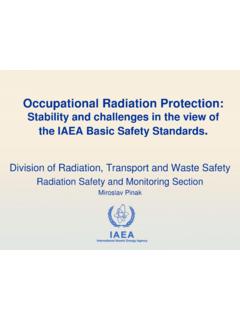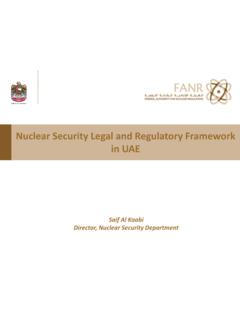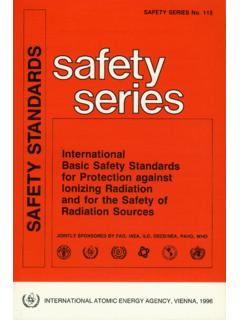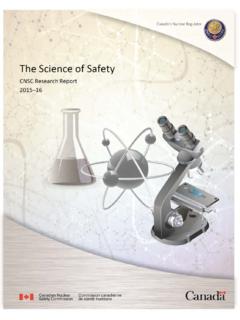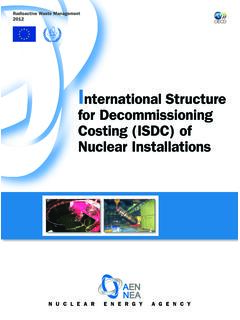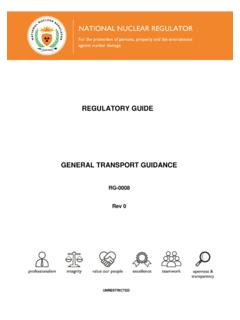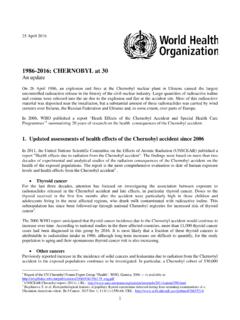Transcription of Safety Assessment Principles for Nuclear Facilities
1 Safety Assessment Principles for Nuclear Facilities2014 EditionRevision 0 Safety Assessment Principles for Nuclear Facilities UNCONTROLLED COPY IF NOT VIEWED ON ONR WEBSITE 2014 Edition, Revision 0 Page 2 of 225 Version Control The 2014 revision of the Safety Assessment Principles (SAPs) was completed in November 2014 and is reflected in this document. Changes may need to be made to this document as time moves on, eg amending minor typing errors, or accommodating any significant changes affecting the Office for Nuclear Regulation (ONR). For this reason the website version is the only authorised version. To avoid any confusion and provide some form of version control over the guidance, every page in this paper copy is marked as uncontrolled if not viewed on ONR website. This signals that at a future date the information may change, and it is the responsibility of each individual to cross reference any copy with the most up to date version published on the ONR website.
2 Where amendments are made to the document, these will be published on the ONR website ( ) with an audit trail and, where possible, stakeholders will be alerted to the changes. The following documents are also available under the Nuclear pages of the ONR website: A cross-reference table between the 2006 SAPs and the 2014 SAPs. ONR s response to comments received. Revision History No. Date Change summary Safety Assessment Principles for Nuclear Facilities UNCONTROLLED COPY IF NOT VIEWED ON ONR WEBSITE 2014 Edition, Revision 0 Page 3 of 225 Page FOREWORD .. 5 7 FUNDAMENTAL 16 FP Fundamental 16 LEADERSHIP AND MANAGEMENT FOR 18 MS Leadership and management for 18 THE REGULATORY Assessment OF Safety 24 SC Safety 24 SITING 33 ST Siting.
3 33 ENGINEERING 37 EKP Key 37 ECS Safety classification and 40 EQU Equipment 43 EDR Design for 44 ERL Reliability 45 ECM 47 EMT Maintenance, inspection and 48 EAD Ageing and 50 ELO 51 EHA External and internal 53 EPS Pressure 62 EMC Integrity of metal components and 63 ENC Integrity of non-metal components and 75 ECE Civil 77 EGR Graphite reactor 85 ESS Safety 90 ESR Control and instrumentation of Safety -related 98 EES Essential 100 EHF Human 102 ENM Control of Nuclear 107 EPE Chemical (Process) 110 ECH 114 ECV Containment and 117 ERC Reactor 122 EHT Heat transport 125 ECR Criticality 127 RADIATION 129 RP Radiation 129 FAULT 134 FA Fault 134 AV Assurance of validity of data and 146 NUMERICAL TARGETS.
4 150 NT Numerical targets and legal 150 ACCIDENT MANAGEMENT AND EMERGENCY 165 AM Accident management and emergency 165 RADIOACTIVE WASTE 169 RW Radioactive waste 169 178 DC 178 LAND QUALITY 187 RL Strategies for radioactively contaminated 187 ANNEX 1: ONR Regulatory 195 Safety Assessment Principles for Nuclear Facilities UNCONTROLLED COPY IF NOT VIEWED ON ONR WEBSITE 2014 Edition, Revision 0 Page 4 of 225 ANNEX 2: Basis and Derivation of Numerical 197 210 211 222 225 FURTHER 226 Note Throughout the document individual paragraphs are numbered, but for clarity of presentation Principles are presented in boxes and separately numbered. The numbering of Principles is of the form or etc, where XY and XYZ represent the thematic headings Assessment Principles for Nuclear Facilities UNCONTROLLED COPY IF NOT VIEWED ON ONR WEBSITE 2014 Edition, Revision 0 Page 5 of 225 FOREWORD The Office for Nuclear Regulation (ONR) is the independent regulator of Nuclear Safety and security across the UK.
5 ONR s inspectors use these Safety Assessment Principles (SAPs), together with supporting Technical Assessment Guides (TAGs), to guide their regulatory judgements and recommendations when undertaking technical assessments of Nuclear site licensees Safety submissions. Underpinning these is the legal duty on licensees to reduce risks so far as is reasonably practicable, and this informs the use of these SAPs. In addition, the SAPs are used to guide our assessments of proposed new Nuclear Facilities designs that may come forward for eventual construction at sites in the UK. The 2006 version of the SAPs built upon earlier publications (1979, 1983, 1988 and 1992) taking account of developments in Nuclear Safety and its regulation, both internationally and in the UK. This 2014 revision of the SAPs was prompted by publication in 2011 of the Chief Nuclear Inspector s report on the implications of the Fukushima accident for the UK Nuclear industry.
6 That report concluded that there were no significant gaps in the 2006 Safety Assessment Principles , but recommended a review to ensure that lessons learned were incorporated. That review is now complete and this document contains the results. For purposes of continuity and clarity the revised SAPs retain the 2006 identifiers. In addition to the lessons from Fukushima, we have also taken account of recent work by the International Atomic Energy Agency (IAEA), in particular the development of IAEA s design standard on the Safety of Nuclear power plants (SSR 2/1). As with the previous version of the SAPs, we believe that they are fully in line with IAEA guidance and standards. We acknowledge that these SAPs cannot reflect the breadth and depth of the entire suite of IAEA publications and so we explicitly identify those documents as relevant good practices within our TAGs.
7 IAEA guidance recommends that regulatory bodies subject their Principles , regulations and guidance to periodic review, and take account of internationally endorsed standards and guidance. Although the SAPs have been reviewed and revised a number of times over the years, we acknowledge the importance of regular reviews and will formalise arrangements to carry out future reviews of the SAPs at least every five years. ONR is an active member of the Western European Nuclear Regulators' Association (WENRA), which is dedicated to ensuring that all European Union countries and candidate countries with civil Nuclear power stations as well as Switzerland have harmonised levels of Nuclear Safety . To this end, WENRA has developed reference levels that represent good practices for existing civil Nuclear power plants, radioactive waste management and decommissioning.
8 ONR has previously acknowledged the reference levels as relevant good practice. It has now reviewed the most recent version of the reference levels, themselves recently revised to take account of learning from Fukushima, to ensure compatibility with the SAPs. These reference levels are also explicitly referenced in the ONR TAGs that support these SAPs. The Defence Nuclear Safety Regulator (DNSR) the Environment Agency (EA) and the Scottish Environment Protection Agency (SEPA) have supported ONR in this revision of the SAPs and their contribution is gratefully acknowledged. Safety Assessment Principles for Nuclear Facilities UNCONTROLLED COPY IF NOT VIEWED ON ONR WEBSITE 2014 Edition, Revision 0 Page 6 of 225 This revision of the SAPs has been informed by comments and views submitted to us in response to an open invitation on ONR s website.
9 In many cases these have led us to modify the text. However, decisions on the final text and responsibility for the SAPs content are ours alone. Dr A N Hall Chief Nuclear Inspector Office for Nuclear Regulation November 2014 Safety Assessment Principles for Nuclear Facilities Introduction UNCONTROLLED COPY IF NOT VIEWED ON ONR WEBSITE 2014 Edition, Revision 0 Page 7 of 225 INTRODUCTION The purpose of the Safety Assessment Principles (SAPs) 1. The SAPs apply to assessments of Safety at existing or proposed Nuclear Facilities . This is usually through our Assessment of Safety cases in support of regulatory decisions. The term Safety case is used throughout this document to encompass the totality of the documentation developed by a designer, licensee or duty-holder to demonstrate high standards of Nuclear Safety and radioactive waste management, and any subset of this documentation that is submitted to the Office for Nuclear Regulation (ONR).
10 2. The Principles presented in this document relate only to Nuclear Safety , radiation protection and radioactive waste management. Conventional hazards associated with a Nuclear facility are excluded, except where they have a direct effect on Nuclear Safety or radioactive waste management. The use of the word Safety within the document should therefore be interpreted accordingly. 3. The primary purpose of the SAPs is to provide inspectors with a framework for making consistent regulatory judgements on the Safety of activities. The Principles are supported by Technical Assessment Guides (TAGs), and other guidance, to further assist decision making within the Nuclear Safety regulatory process (see the ONR website). Although it is not their prime purpose, the SAPs may also provide guidance to designers and duty-holders on the appropriate content of Safety cases, clarifying our expectations in this regard.










